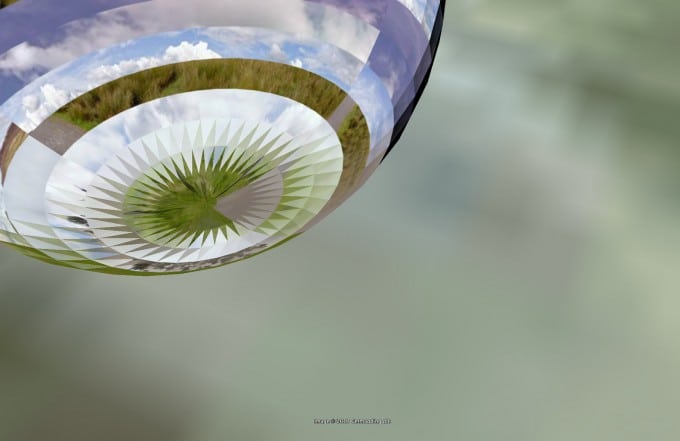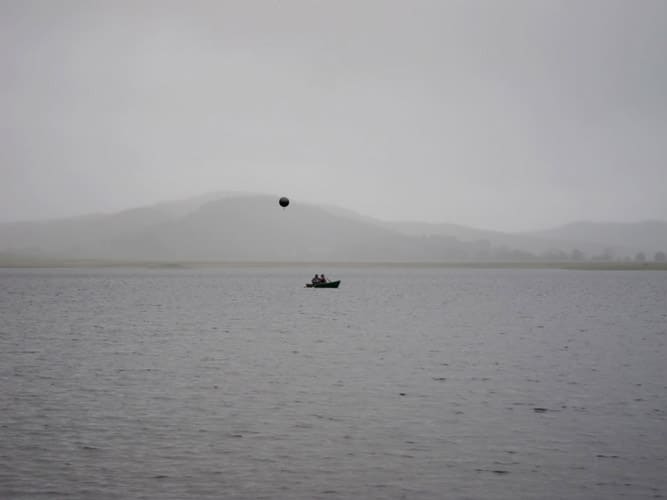Space Inscribed,
Esther Polak and Ivar van Bekkum at HICA
by: Murdo Macdonald, Professor of History of Scottish Art at the University of Dundee.
Download the article in pdf here.
I used to watch movies on long flights. Now I watch the GPS track as I am inscribed upon a map in juxtaposition with guidance beacons and mysterious ocean ridges. GPS is a tool for that oldest of activities, drawing, and like any other way of drawing, artists use it according to their insight and ability. As ever, some mistake the technique itself for art. As ever, some do not. Talbot called light ‘the pencil of nature’ and GPS is a pencil of technology inscribed on an image of nature. But just as Talbot’s pioneering photographs would have been of no interest had they not had aesthetic impact, so also with GPS. The work of Esther Polak and Ivar van Bekkum at HICA in September and October 2010 showed their understanding of the possibilities of GPS as a medium. The work is ecological in a true sense: it illuminates ourselves and the habitats, urban and non-urban, that we share with each other and other living beings. It is thus both personal and planetary. Here is the absolute localisation, personalisation, made possible by global surveillance technology, its use by artists not so much an irony as an unintended consequence. Here the GPS tracks become real by imposing them on an illusion, the pre-recorded planetary surface as recorded on Google Earth. And yet this illusion is apposite for it reminds us that by the time we see the track it is itself also illusion. We are so used to these illusions that track reality. The track of an atomic particle in a Cloud Chamber: what could be more, or less, real? The perception of crossing a street: made real from, in William James’ words, a ‘blooming buzzing confusion’ of input by the processes of brain and mind. Is that reality? Well I suppose it must be. No wonder we like GPS as a mode of perception: it is just another way of organising that confusion. It is in this border territory where neither reality nor illusion gains the upper hand that artists work. Here, perhaps one can argue that the medium is indeed itself the message, for a GPS track is as absolutely real or as absolutely illusory as I myself was when I began to write this sentence and as my future self will be when I finish it, that is to say now. My then future self is now, of course, a past illusion rather than a future illusion, just another blip marked by the track of my pencil or the keystroke on my laptop, or my position on a track, GPS or otherwise. Well, as Melville noted in Moby Dick, ‘it is not on any map, true places never are’.

Esther Polak and Ivar van Bekkum call their work at HICA Abstract View and it is certainly that. But, as Geoff Lucas, one of the founders of HICA, noted to me, art is a process of continuous abstraction complemented by continuous concretisation. Pulling apart and reassembling. Deconstruction and reconstruction. The order of abstraction and the chaos of reality or the chaos of abstraction and the order of reality. David Hume wrote about abstraction with the most concrete of examples. He asks his reader to imagine not a black cube, but a cube of black marble. What could be more concrete than that. And alongside it he asks you to imagine a cube of white marble. And similarly a sphere of white marble and a sphere of black marble. What an opportunity for a monument to Hume is given in this passage, and yet in a way his radically cylindrical memorial designed by Robert Adam and built in 1777 indicates just such a visual understanding of the philosopher. One wonders if Goethe had read Hume’s passage before he made his cube and sphere sculpture in his garden at Weimar. That conjunction of the forms of visual thinking across eighteenth-century Europe is interesting.
The more I write the less I want to describe Esther and Ivar’s work in detail. That is the greatest compliment I can give it for, as is the way with good art, it engenders thought, it pushes you immediately past the detail of the work. It makes a space within which you can think. Nevertheless I must make some attempt for the sake of the reader who did not see it. Creating and responding to art out of doors in the Highlands of Scotland is about weather. In the 1890s William McTaggart needed ropes and members of his family to keep his canvas on the easel at Machrihanish as he witnessed the weather and the people who lived with it. In 2010 these two artists witnessed the weather in a different way, but just as with McTaggart their work is made by human response to the interaction of land, wind and water.
The poet Iain Crichton Smith talks of building from the rain and the stones, in an ecological metaphor of Highland cultural renewal, a cultural renewal of which HICA deserves to be a key part. Abstract View built from the wind and the hills, both in gallery exhibited work and in a key performance in which continuous rain, far from undermining the experience, contributed to it. At one point spectators huddled in a damp boat house avoiding the rising water level of a burn that was normally little more than a trickle. Framed for us out on Loch Ruthven the two artists launched balloons – green, yellow, red, blue, black – into veils of heavy rain. Hume met De Stijl in the Highlands. The rain relented to give a view of bright points of colour blown in the wind across a grey landscape, each connected to the surface of the loch by a float, and each sending a double GPS signal. This performance was drawn out,thanks to the wind direction, almost as if on a film screen in front of us. And the electronic wind-drawings themselves were recovered via GPS transmitters, satellites and computers and generated for viewing later in the day. An abstract view indeed. That synthesis with the wind was complemented by another profoundly ecological work projected in the gallery space itself, a collaboration with the local farmer in which the tracks generated by sheep and sheepdog became an expressive, enjoyable and informative dance of nature and husbandry.
Presences of other artists inform the background of this work. The proportionate landscape interventions of Donald Judd, the traditional innovations of the 19th century landscape painter Antoine Mauve, the conceptual elegance of Yoko Ono. Esther quotes Yoko Ono: ‘Draw an imaginary map and follow it down an actual street.’ Exactly. What else could an artist – or a philosopher – possibly do? Yoko Ono’s comment is a reminder that so many of the artists of the present are revisiting the ideas of the late 1960s; artists like Yoko Ono and John Latham are at last being given the recognition they deserve.
The focus of the piece by Polak and Van Bekkum on the movement of the air was ecological in the deepest sense. In most cultures the wind is personified, indeed deified. The classical world gives us Aeolus, the supervisor of the winds, who gave his name to the Aeolian Harp, an instrument played by the wind, which is at the core of a myth of the origin of music. This link of air and culture reminds us that the first coding of language – the first act that enabled it to be stable – was song, and from song it is only a step to the naming of the landscape. Where once we sang we now draw with GPS ‘singing’ the landscape into being in a new way.
